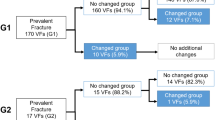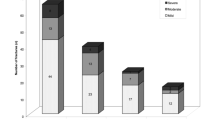Abstract
Introduction
Approaches for recognizing vertebral fractures remain controversial.
Methods
An age-stratified population sample of 512 postmenopausal women was followed with serial radiographs for up to 12 years (4455 person-years).
Results
112 women experienced a new vertebral fracture (20% reduction in any vertebral height from baseline) within this study period, for an annual age-adjusted (to US white women ≥50 years of age in 2000) incidence of 23 per 1000. Depending on the morphometric definition used, the prevalence of vertebral deformities at baseline ranged from 3 to 90%. A recent method to standardize vertebral heights produced the best agreement with a qualitative clinical reading of the films [kappa (κ), 0.53]. Almost all of the different baseline definitions predicted future vertebral fractures, but most of the predictive power was attributable to the severe (e.g., 4 SD) deformities included within more generous (e.g., 3 SD) classifications. Whereas the generous definitions were more sensitive, and the restrictive ones more specific, their overall abilities to predict a new vertebral fracture were roughly comparable as evaluated by the c-index (analogous to the area under an ROC curve).
Conclusion
This result suggests that the choice of a morphometry definition depends on the particular application and, in particular, on whether it is more important to maximize sensitivity or specificity.
Similar content being viewed by others
References
Cummings SR, Melton LJ III (2002) Epidemiology and outcomes of osteoporotic fractures. Lancet 359:1761–1767
Anonymous (1995) Assessing vertebral fractures. National Osteoporosis Foundation Working Group on Vertebral Fractures. J Bone Miner Res 10:518–523
Kanis JA, McCloskey EV, Kahn S, Nakatsuka K, Sirtori P (1993) What is a vertebral fracture? In: Christiansen C, Riis B (eds) Proc 4th Int Symp Osteoporos Consensus Dev Conf. Aalborg, Handelstrykkeriet Aalborg, pp 26–28
McCloskey EV, Spector TD, Eyres KS, Fern ED, O’Rourke N, Vasikaran S, Kanis JA (1993) The assessment of vertebral deformity: a method for use in population studies and clinical trials. Osteoporos Int 3:138–147
Melton LJ III, Egan KS, O’Fallon WM, Riggs BL (1998) Influence of fracture criteria on the outcome of a randomized trial of therapy. Osteoporos Int 8:184–191
Black DM, Palermo L, Nevitt MC, Genant HK, Christensen L, Cummings SR (1999) Defining incident vertebral deformity: a prospective comparison of several approaches. The study of Osteoporotic Fractures Research Group. J Bone Miner Res 14:90–101
Ferrar L, Jiang G, Adams J, Eastell R (2005) Identification of vertebral fractures: an update. Osteoporos Int 16:717–728
Genant HK, Jergas M (2003) Assessment of prevalent and incident vertebral fractures in osteoporosis research. Osteoporos Int 14[Supplement 3]:S43–S55
Ettinger B, Black DM, Nevitt MC, Rundle AC, Cauley JA, Cummings SR, Genant HK (1992) Contribution of vertebral deformities to chronic back pain and disability. The study of Osteoporotic Factures Research Group. J Bone Miner Res 7:449–456
Burger H, Van Daele PL, Grashuis K, Hofman A, Grobbee DE, Schutte HE, Birkenhager JC, Pols HA (1997) Vertebral deformities and functional impairment in men and women. J Bone Miner Res 12:152–157
Ross PD, Yhee YK, He Y-F, Davis JW, Kamimoto C, Epstein RS, Wasnich RD (1993) A new method for vertebral fracture diagnosis. J Bone Miner Res 8:167–174
Jiang G, Eastell R, Barrington NA, Ferrar L (2004) Comparison of methods for the visual identification of prevalent vertebral fracture in osteoporosis. Osteoporos Int 15:887–896
Klotzbuecher CM, Ross PD, Landsman PB, Abbott TA III, Berger M (2000) Patients with prior fractures have an increased risk of future fractures: a summary of the literature and statistical synthesis. J Bone Miner Res 15:721–739
Lindsay R, Silverman SL, Cooper C, Hanley DA, Barton I, Broy SB, Licata A, Benhamou L, Geusens P, Flowers K, Stracke H, Seeman E (2001) Risk of new vertebral fracture in the year following a fracture. JAMA 285:320–323
Melton LJ III (1996) History of the Rochester Epidemiology Project. Mayo Clin Proc 71:266–274
Melton LJ III, Kan SH, Frye MA, Wahner HW, O’Fallon WM, Riggs BL (1989) Epidemiology of vertebral fractures in women. Am J Epidemiol 129:1000–1011
Melton LJ III, Lane AW, Cooper C, Eastell R, O’Fallon WM, Riggs BL (1993) Prevalence and incidence of vertebral deformities. Osteoporos Int 3:113–119
Melton LJ III, Khosla S, Atkinson EJ, O’Fallon WM, Riggs BL (1997) Relationship of bone turnover to bone density and fractures. J Bone Miner Res 12:1083–1091
Eastell R, Cedel SL, Wahner HW, Riggs BL, Melton LJ III (1991) Classification of vertebral fractures. J Bone Miner Res 6:207–215
Black DM, Cummings SR, Stone K, Hudes E, Palermo L, Steiger P (1991) A new approach to defining normal vertebral dimensions. J Bone Miner Res 6:883–892
Jiang G (2002) Approaches to the identification of vertebral fractures. PhD thesis, University of Sheffield, Sheffield, UK pp 99–100
Black DM, Palermo L, Nevitt MC, Genant HK, Epstein R, San Valentin R, Cummings SR (1995) Comparison of methods for defining prevalent vertebral deformities: The study of Osteoporotic Fractures. J Bone Miner Res 10:890–902
Harrell FE Jr, Lee KL, Mark DB (1996) Multivariable prognostic models: issues in developing models, evaluating assumptions and adequacy, and measuring and reducing errors. Stat Med 15:361–387
Deyo RA, McNiesh LM, Cone RO III (1985) Observer variability in the interpretation of lumbar spine radiographs. Arthritis Rheum 28:1066–1070
Davies KM, Recker RR, Heaney RP (1989) Normal vertebral dimensions and normal variation in serial measurements of vertebrae. J Bone Miner Res 4:341–349
Espeland A, Korsbrekke K, Albrektsen G, Larsen JL (1998) Observer variation in plain radiography of the lumbosacral spine. Br J Radiol 71:366–375
Gehlbach SH, Bigelow C, Heimisdottir M, May S, Walker M, Kirkwood JR (2000) Recognition of vertebral fracture in a clinical setting. Osteoporos Int 11:577–582
Delmas PD, van de Langerijt L, Watts NB, Eastell R, Genant H, Grauer A, Cahall DL, for the IMPACT Study Group (2005) Underdiagnosis of vertebral fractures is a worldwide problem: the IMPACT Study. J Bone Miner Res 20:557–563
Greenspan SL, von Stetten E, Emond SK, Jones L, Parker RA (2001) Instant vertebral assessment: a noninvasive dual X-ray absorptiometry technique to avoid misclassification and clinical mismanagement of osteoporosis. J Clin Densitom 4:373–380
Vokes TJ, Dixon LB, Favus MJ (2003) Clinical utility of dual-energy vertebral assessment (DVA). Osteoporos Int 14:871–878
Genant HK, Li J, Wu CY, Shepherd JA (2000) Vertebral fractures in osteoporosis: a new method for clinical assessment. J Clin Densitom 3:281–290
Ferrar L, Jiang G, Eastell R, Peel NFA (2003) Visual identification of vertebral fractures in osteoporosis using morphometric X-ray absorptiometry. J Bone Miner Res 18:933–938
Smith-Bindman R, Cummings SR, Steiger P, Genant HK (1991) A comparison of morphometric definitions of vertebral fracture. J Bone Miner Res 6:25–34
Nicholson PHF, Haddaway MJ, Davie MWJ, Evans SF (1993) Vertebral deformity, bone mineral density, back pain and height loss in unscreened women over 50 years. Osteoporos Int 3:300–307
Matthis C, Weber U, O’Neill TW, Raspe H (1998) Health impact associated with vertebral deformities: results from the European Vertebral Osteoporosis Study (EVOS). Osteoporos Int 8:364–372
Jones G, White C, Nguyen T, Sambrook PN, Kelly PJ, Eisman JA (1996) Prevalent vertebral deformities: relationship to bone mineral density and spinal osteophytosis in elderly men and women. Osteoporos Int 6:233–239
Leidig-Bruckner G, Limberg B, Felsenberg D, Bruckner T, Holder S, Kather A, Miksch J, Wüster C, Ziegler R, Scheidt-Nave C (2000) Sex difference in the validity of vertebral deformities as an index of prevalent vertebral osteoporotic fractures: a population survey of older men and women. Osteoporos Int 11:102–119
Melton LJ III, Atkinson EJ, Khosla S, O’Fallon WM, Riggs BL (1999) Secondary osteoporosis and the risk of vertebral deformities in women. Bone 24:49–55
Li J, Wu CY, Jergas M, Genant HK (1995) Diagnosing prevalent vertebral fractures: a comparison between quantitative morphometry and a standardized visual (semiquantitative) approach. In: Genant HK, Jergas M, van Kuijk C (eds) Vertebral fracture in osteoporosis. Radiology Research and Education Foundation, San Francisco, pp 271–279
Jackson SA, Tenenhouse A, Robertson L (2000) Vertebral fracture definition from population-based data: preliminary results from the Canadian Multicenter Osteoporosis Study (CaMos). Osteoporos Int 11:680–687
U.S. Department of Health and Human Services (2004) Chapter 4. The frequency of bone disease. In: Bone Health and Osteoporosis. A report of the surgeon general. U.S. Department of Health and Human Services, Rockville, Md., pp 68–87
Cooper C, Atkinson EJ, O’Fallon WM, Melton LJ III (1992) Incidence of clinically diagnosed vertebral fractures: a population-based study in Rochester, Minnesota, 1985–1989. J Bone Miner Res 7:221–227
Fink HA, Milavetz DL, Palermo L, Nevitt MC, Cauley JA, Genant HK, Black DM, Ensrud K, for the Fracture Intervention Trial Research Group (2005) What proportion of incident radiographic vertebral deformities is clinically diagnosed and vice versa? J Bone Miner Res 20:1216–1222
Melton LJ III, Kallmes DF (in press) Epidemiology of vertebral fractures: implication for vertebroplasty. Acad Radiol
Nelson DA, Kleerekoper M, Peterson EL (1994) Reversal of vertebral deformities in osteoporosis: measurement error or “rebound”? J Bone Miner Res 9:977–982
McKiernan F, Jensen R, Faciszewski T (2003) The dynamic mobility of vertebral compression fractures. J Bone Miner Res 18:24–29
Lunt M, Gowin W, Johnell O, Armbrecht G, Felsenberg D, Reeve J, on behalf of the EPOS Study Group (2001) A statistical method to minimize magnification errors in serial vertebral radiographs. Osteoporos Int 12:909–913
Lyritis GP, Mayasis, B, Tsakalakos N, Lambropoulos A, Gazi S, Karachalios T, Tsekoura M, Yiatzides A (1989) The natural history of the osteoporotic vertebral fracture. Clin Rheumatol 8[Supplement 2]:66–69
Ross PD, Davis JW, Epstein RS, Wasnich RD (1992) Ability of vertebral dimensions from a single radiograph to identify fractures. Calcif Tissue Int 51:95–99
Acknowledgements
This project was supported in part by grants AR-27065 and AR-30582 from the National Institutes of Health, U.S. Public Health Service. Digitization of the radiographs was partly supported by a grant from Merck, Sharp and Dohme Research Laboratories. The authors would like to thank Diana Hansen and Margaret Holets for digitizing the radiographs and Mary Roberts for help in preparing the manuscript.
Author information
Authors and Affiliations
Corresponding author
Rights and permissions
About this article
Cite this article
Melton, L.J., Wenger, D.E., Atkinson, E.J. et al. Influence of baseline deformity definition on subsequent vertebral fracture risk in postmenopausal women. Osteoporos Int 17, 978–985 (2006). https://doi.org/10.1007/s00198-006-0106-1
Received:
Accepted:
Published:
Issue Date:
DOI: https://doi.org/10.1007/s00198-006-0106-1




